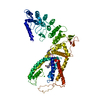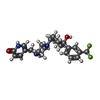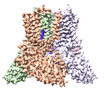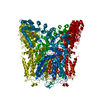[English] 日本語
 Yorodumi
Yorodumi- EMDB-22665: Cryo-EM structure of human TRPV6 in complex with (4- phenylcycloh... -
+ Open data
Open data
- Basic information
Basic information
| Entry | Database: EMDB / ID: EMD-22665 | ||||||||||||||||||
|---|---|---|---|---|---|---|---|---|---|---|---|---|---|---|---|---|---|---|---|
| Title | Cryo-EM structure of human TRPV6 in complex with (4- phenylcyclohexyl)piperazine inhibitor 3OG | ||||||||||||||||||
 Map data Map data | TRPV6 in complex with (4- phenylcyclohexyl)piperazine inhibitor 3OG | ||||||||||||||||||
 Sample Sample |
| ||||||||||||||||||
 Keywords Keywords | TRPV6 / ion channel / inhibitor / MEMBRANE PROTEIN / MEMBRANE PROTEIN-INHIBITOR complex | ||||||||||||||||||
| Function / homology |  Function and homology information Function and homology informationparathyroid hormone secretion / regulation of calcium ion-dependent exocytosis / TRP channels / calcium ion import across plasma membrane / calcium ion homeostasis / calcium channel complex / calcium ion transmembrane transport / calcium channel activity / response to calcium ion / calcium ion transport ...parathyroid hormone secretion / regulation of calcium ion-dependent exocytosis / TRP channels / calcium ion import across plasma membrane / calcium ion homeostasis / calcium channel complex / calcium ion transmembrane transport / calcium channel activity / response to calcium ion / calcium ion transport / calmodulin binding / metal ion binding / identical protein binding / plasma membrane Similarity search - Function | ||||||||||||||||||
| Biological species |  Homo sapiens (human) Homo sapiens (human) | ||||||||||||||||||
| Method | single particle reconstruction / cryo EM / Resolution: 3.66 Å | ||||||||||||||||||
 Authors Authors | Neuberger A / Nadezhdin KD | ||||||||||||||||||
| Funding support |  United States, 5 items United States, 5 items
| ||||||||||||||||||
 Citation Citation |  Journal: Sci Adv / Year: 2020 Journal: Sci Adv / Year: 2020Title: Inactivation-mimicking block of the epithelial calcium channel TRPV6. Authors: Rajesh Bhardwaj / Sonja Lindinger / Arthur Neuberger / Kirill D Nadezhdin / Appu K Singh / Micael R Cunha / Isabella Derler / Gergely Gyimesi / Jean-Louis Reymond / Matthias A Hediger / ...Authors: Rajesh Bhardwaj / Sonja Lindinger / Arthur Neuberger / Kirill D Nadezhdin / Appu K Singh / Micael R Cunha / Isabella Derler / Gergely Gyimesi / Jean-Louis Reymond / Matthias A Hediger / Christoph Romanin / Alexander I Sobolevsky /     Abstract: Epithelial calcium channel TRPV6 plays vital roles in calcium homeostasis, and its dysregulation is implicated in multifactorial diseases, including cancers. Here, we study the molecular mechanism of ...Epithelial calcium channel TRPV6 plays vital roles in calcium homeostasis, and its dysregulation is implicated in multifactorial diseases, including cancers. Here, we study the molecular mechanism of selective nanomolar-affinity TRPV6 inhibition by (4-phenylcyclohexyl)piperazine derivatives (PCHPDs). We use x-ray crystallography and cryo-electron microscopy to solve the inhibitor-bound structures of TRPV6 and identify two types of inhibitor binding sites in the transmembrane region: (i) modulatory sites between the S1-S4 and pore domains normally occupied by lipids and (ii) the main site in the ion channel pore. Our structural data combined with mutagenesis, functional and computational approaches suggest that PCHPDs plug the open pore of TRPV6 and convert the channel into a nonconducting state, mimicking the action of calmodulin, which causes inactivation of TRPV6 channels under physiological conditions. This mechanism of inhibition explains the high selectivity and potency of PCHPDs and opens up unexplored avenues for the design of future-generation biomimetic drugs. | ||||||||||||||||||
| History |
|
- Structure visualization
Structure visualization
| Movie |
 Movie viewer Movie viewer |
|---|---|
| Structure viewer | EM map:  SurfView SurfView Molmil Molmil Jmol/JSmol Jmol/JSmol |
| Supplemental images |
- Downloads & links
Downloads & links
-EMDB archive
| Map data |  emd_22665.map.gz emd_22665.map.gz | 59.9 MB |  EMDB map data format EMDB map data format | |
|---|---|---|---|---|
| Header (meta data) |  emd-22665-v30.xml emd-22665-v30.xml emd-22665.xml emd-22665.xml | 16.9 KB 16.9 KB | Display Display |  EMDB header EMDB header |
| Images |  emd_22665.png emd_22665.png | 189.8 KB | ||
| Filedesc metadata |  emd-22665.cif.gz emd-22665.cif.gz | 6.7 KB | ||
| Archive directory |  http://ftp.pdbj.org/pub/emdb/structures/EMD-22665 http://ftp.pdbj.org/pub/emdb/structures/EMD-22665 ftp://ftp.pdbj.org/pub/emdb/structures/EMD-22665 ftp://ftp.pdbj.org/pub/emdb/structures/EMD-22665 | HTTPS FTP |
-Related structure data
| Related structure data |  7k4dMC  7d2kC  7k4aC  7k4bC  7k4cC  7k4eC  7k4fC C: citing same article ( M: atomic model generated by this map |
|---|---|
| Similar structure data |
- Links
Links
| EMDB pages |  EMDB (EBI/PDBe) / EMDB (EBI/PDBe) /  EMDataResource EMDataResource |
|---|---|
| Related items in Molecule of the Month |
- Map
Map
| File |  Download / File: emd_22665.map.gz / Format: CCP4 / Size: 64 MB / Type: IMAGE STORED AS FLOATING POINT NUMBER (4 BYTES) Download / File: emd_22665.map.gz / Format: CCP4 / Size: 64 MB / Type: IMAGE STORED AS FLOATING POINT NUMBER (4 BYTES) | ||||||||||||||||||||||||||||||||||||||||||||||||||||||||||||||||||||
|---|---|---|---|---|---|---|---|---|---|---|---|---|---|---|---|---|---|---|---|---|---|---|---|---|---|---|---|---|---|---|---|---|---|---|---|---|---|---|---|---|---|---|---|---|---|---|---|---|---|---|---|---|---|---|---|---|---|---|---|---|---|---|---|---|---|---|---|---|---|
| Annotation | TRPV6 in complex with (4- phenylcyclohexyl)piperazine inhibitor 3OG | ||||||||||||||||||||||||||||||||||||||||||||||||||||||||||||||||||||
| Projections & slices | Image control
Images are generated by Spider. | ||||||||||||||||||||||||||||||||||||||||||||||||||||||||||||||||||||
| Voxel size | X=Y=Z: 0.95 Å | ||||||||||||||||||||||||||||||||||||||||||||||||||||||||||||||||||||
| Density |
| ||||||||||||||||||||||||||||||||||||||||||||||||||||||||||||||||||||
| Symmetry | Space group: 1 | ||||||||||||||||||||||||||||||||||||||||||||||||||||||||||||||||||||
| Details | EMDB XML:
CCP4 map header:
| ||||||||||||||||||||||||||||||||||||||||||||||||||||||||||||||||||||
-Supplemental data
- Sample components
Sample components
-Entire : sample 1
| Entire | Name: sample 1 |
|---|---|
| Components |
|
-Supramolecule #1: sample 1
| Supramolecule | Name: sample 1 / type: complex / ID: 1 / Parent: 0 / Macromolecule list: #1 |
|---|---|
| Source (natural) | Organism:  Homo sapiens (human) Homo sapiens (human) |
-Macromolecule #1: Transient receptor potential cation channel subfamily V member 6
| Macromolecule | Name: Transient receptor potential cation channel subfamily V member 6 type: protein_or_peptide / ID: 1 / Number of copies: 4 / Enantiomer: LEVO |
|---|---|
| Source (natural) | Organism:  Homo sapiens (human) Homo sapiens (human) |
| Molecular weight | Theoretical: 77.021805 KDa |
| Recombinant expression | Organism:  Homo sapiens (human) Homo sapiens (human) |
| Sequence | String: MGLSLPKEKG LILCLWSKFC RWFQRRESWA QSRDEQNLLQ QKRIWESPLL LAAKDNDVQA LNKLLKYEDC KVHQRGAMGE TALHIAALY DNLEAAMVLM EAAPELVFEP MTSELYEGQT ALHIAVVNQN MNLVRALLAR RASVSARATG TAFRRSPCNL I YFGEHPLS ...String: MGLSLPKEKG LILCLWSKFC RWFQRRESWA QSRDEQNLLQ QKRIWESPLL LAAKDNDVQA LNKLLKYEDC KVHQRGAMGE TALHIAALY DNLEAAMVLM EAAPELVFEP MTSELYEGQT ALHIAVVNQN MNLVRALLAR RASVSARATG TAFRRSPCNL I YFGEHPLS FAACVNSEEI VRLLIEHGAD IRAQDSLGNT VLHILILQPN KTFACQMYNL LLSYDRHGDH LQPLDLVPNH QG LTPFKLA GVEGNTVMFQ HLMQKRKHTQ WTYGPLTSTL YDLTEIDSSG DEQSLLELII TTKKREARQI LDQTPVKELV SLK WKRYGR PYFCMLGAIY LLYIICFTMC CIYRPLKPRT NNRTSPRDNT LLQQKLLQEA YMTPKDDIRL VGELVTVIGA IIIL LVEVP DIFRMGVTRF FGQTILGGPF HVLIITYAFM VLVTMVMRLI SASGEVVPMS FALVLGWCNV MYFARGFQML GPFTI MIQK MIFGDLMRFC WLMAVVILGF ASAFYIIFQT EDPEELGHFY DYPMALFSTF ELFLTIIDGP ANYNVDLPFM YSITYA AFA IIATLLMLNL LIAMMGDTHW RVAHERDELW RAQIVATTVM LERKLPRCLW PRSGICGREY GLGDRWFLRV EDRQDLN RQ RIQRYAQAFH TRGSEDLDKD SVEKLVPR UniProtKB: Transient receptor potential cation channel subfamily V member 6 |
-Macromolecule #2: 5-[(4-{trans-4-hydroxy-4-[3-(trifluoromethyl)phenyl]cyclohexyl}pi...
| Macromolecule | Name: 5-[(4-{trans-4-hydroxy-4-[3-(trifluoromethyl)phenyl]cyclohexyl}piperazin-1-yl)methyl]pyridin-2(1H)-one type: ligand / ID: 2 / Number of copies: 5 / Formula: VUM |
|---|---|
| Molecular weight | Theoretical: 435.483 Da |
| Chemical component information |  ChemComp-VUM: |
-Macromolecule #3: CALCIUM ION
| Macromolecule | Name: CALCIUM ION / type: ligand / ID: 3 / Number of copies: 2 / Formula: CA |
|---|---|
| Molecular weight | Theoretical: 40.078 Da |
-Experimental details
-Structure determination
| Method | cryo EM |
|---|---|
 Processing Processing | single particle reconstruction |
| Aggregation state | particle |
- Sample preparation
Sample preparation
| Concentration | 3 mg/mL | ||||||||||||||||||
|---|---|---|---|---|---|---|---|---|---|---|---|---|---|---|---|---|---|---|---|
| Buffer | pH: 8 Component:
| ||||||||||||||||||
| Grid | Model: C-flat-1.2/1.3 / Material: GOLD / Mesh: 200 | ||||||||||||||||||
| Vitrification | Cryogen name: ETHANE / Chamber humidity: 100 % / Chamber temperature: 277 K / Instrument: FEI VITROBOT MARK IV |
- Electron microscopy
Electron microscopy
| Microscope | FEI POLARA 300 |
|---|---|
| Image recording | Film or detector model: GATAN K3 (6k x 4k) / Digitization - Dimensions - Width: 5760 pixel / Digitization - Dimensions - Height: 4092 pixel / Number grids imaged: 1 / Number real images: 7626 / Average exposure time: 3.0 sec. / Average electron dose: 70.9 e/Å2 |
| Electron beam | Acceleration voltage: 300 kV / Electron source:  FIELD EMISSION GUN FIELD EMISSION GUN |
| Electron optics | Illumination mode: FLOOD BEAM / Imaging mode: BRIGHT FIELD |
| Experimental equipment |  Model: Tecnai Polara / Image courtesy: FEI Company |
 Movie
Movie Controller
Controller


















 Z (Sec.)
Z (Sec.) Y (Row.)
Y (Row.) X (Col.)
X (Col.)





















